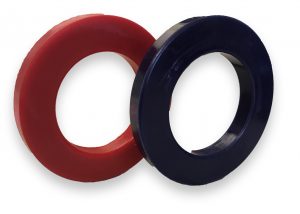Industrial urethane seals are one of Plan Tech’s specialty industrial products that we manufacture. Urethane has a great ability to be resistant to most chemicals and has great sealing properties both in high and low-pressure conditions.

Industrial urethane seals frequently last the lifetime of the machine even after years of abuse and repeated compression set. Industrial urethane seals start as a liquid that is open cast into a mold or poured into a sheet. Plan Tech has a 4’ x 8’ Flow water jet capability of cutting thousands of industrial urethane seals frequently out of just one sheet resulting in a low-cost industrial seal for any application.
Plan Tech also offers many different additives that we can add to the urethane in a liquid state to tailor our urethane for special applications. Most common additives are Flame retardant urethane or to add antistatic properties to the urethane. Currently, Plan Tech supplies hundreds of thousands of industrial urethane seals around the world. One of our customers we originally designed from a simple request over the phone. This just shows Plan Tech is ready willing and able to take on any volume or current design stage and work one on one with our customers to ensure exactly what is expected of industrial urethane seals.
There are several types of molding options when manufacturing industrial urethane seals – some common types are:
Open Cast Molding: Open cast molding is the simplest and most common molding method for thermoset polyurethanes.
Advantages: Since pressures and temperatures in the molding process are relatively low (ambient pressure and temps below 250F), the molds are more cost effective and can be made from a variety of materials including polyurethane. Open cast molding urethane parts is good for parts with relatively open tolerances on one surface. If tolerances are tighter, a secondary finishing operation is an option.
Compression Molding: The part is split on a parting line, the halves are filled and the material is allowed to gel. The mold is then closed and placed into a compression press.
Advantages: Compression molding yields a finished part with detail on all sides. Molds can be more expensive than those used in open casting or transfer, but parts can be quite detailed and elaborate.
Please Contact us for further details regarding industrial urethane seals!
